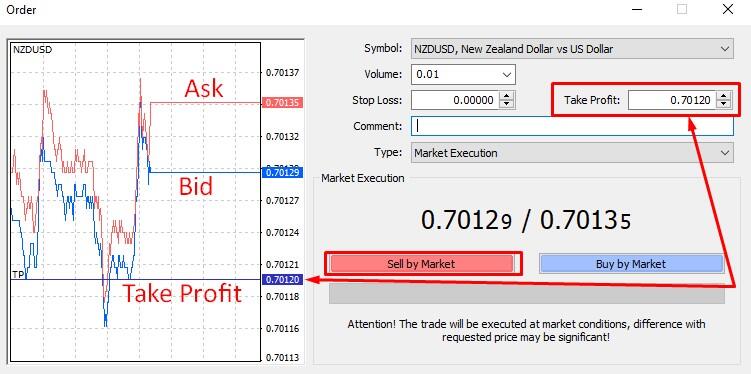take profit and its concept in digital currency
Take Profit and its meaning in digital currency
Take profit in the transaction refers to a certain price in the transaction at which the trader earns profit from the relevant trading position. By using take profit, traders can get out of their trading position at the prices they set and get profit from the transaction. When the trade moves in the direction of the trader’s prediction, the trader tries to preserve the amount of profit by choosing a price to exit the trade and refrains from being more greedy to keep the trade open. To understand the importance of taking a profit, it is necessary to note that without its precise determination, the trader cannot receive the desired profit from the financial markets.
What is Take Profit?
“Take Profit” is the price at which the trading position is closed and the trader profits from the transaction. In fact, the trader sets a target for his trading position, and this target corresponds to tick profit. Therefore, after analyzing the market and opening a position to make a profit, the trader needs to specify a price as a target, which is called the profit take profit.
The take profit order is the registration of the desired price to close the trading position and earn profit. Using the take profit order, the trader instructs the relevant exchange or brokerage to close the desired trading position. Take profit order can be of different types such as limit order, stop limit or stop market.
What is a stop loss?
“Stop Loss” is a type of order placed by the trader at a certain price to prevent loss. When the market price reaches this price, the order is activated and the trading position is closed. Stop loss is one of the tools used in trading risk management, and when the price moves against the trader’s prediction, it prevents further loss by closing the trading position at the set price.
Traders determine the stop loss price according to the amount of risk they accept in the transaction. To determine the stop loss, in addition to taking into account the amount of tolerable risk in trading, traders also use technical analysis tools such as price patterns in the candlestick chart, support and resistance levels, indicators and oscillators.
Take profit and stop loss.
Tick profit and stop loss define profit and loss ranges for the trader and allow the trader to calculate the ratio of profit to loss in the trade. Therefore, the trader can manage the risk in the transactions. When the trader identifies his desired trading position according to the available analysis, at the same time, he must also determine the tick profit and stop loss prices. By choosing these prices, the trader actually determines the amount of possible profit and loss in the relevant position.
The importance of specifying take profit ranges
To better understand the importance of specifying the tick profit range, just note that the tick profit is the same target you set in your transactions. Imagine opening your trading position without a price target. In this case, the transaction is associated with a lot of risk and the possibility of loss in these transactions is very high. Therefore, choosing the target price is necessary for all transactions. In the continuation of this article from Faradars magazine, we will explain some of the reasons for the importance of specifying the tick profit range in transactions.

profit maximization
Specifying the target in the trades allows the trader to have optimal management to carry out his trades and obtain the profit from the trade at the set price. Considering the price fluctuations in the financial markets, by specifying the amount of profit he expects from the relevant transaction by placing a target in the transactions, the trader tries to maintain the amount of profit and avoid the possibility of losing it when the market returns.
Perform optimal risk management.
By using the tick profit order and placing the “Stop Loss”, the trader can calculate the ratio of risk to reward in the transaction. The amount of risk needed to reach the possible goal can be calculated by calculating the risk to reward in the transaction. Using the entry prices, the stop loss price, and the profit tick price, the trader can calculate the profit to loss ratio in the transaction and make an informed decision to carry out the relevant transaction.
Avoiding emotions in the transaction
Traders always face a problem called emotions dominating their trading decisions. Emotions in trading make the trader unable to rationally decide to make his trades and make the trader not act according to his trading strategy.
By choosing the profit tick levels, the trader determines the prices to exit the trade and does not get involved in emotions in making trades. Therefore, when he opens the desired trading position, he determines the loss limit and target prices according to the necessary analysis and does not change the determined prices. The constant change of tick profit prices and loss limits in transactions without any logical reason, which is caused by emotions, is considered one of the most important reasons for failure in transactions.
No need to constantly monitor the market
By specifying the limits of the tick profit and the loss limit of the corresponding position, the trader does not need to constantly monitor the market. In this case, the trader determines the target and the loss limit for the desired position, and the corresponding order is made after the price reaches the desired target.
How to correctly identify tick profit ranges in transactions.
In order to recognize profit-taking limits, the trader needs to follow a specific strategy. This strategy determines how to use technical analysis tools and the ratio of risk to reward. In order to correctly recognize tick profit ranges, the trader must also pay attention to the market volatility and the behavior of the price, and the market trend. The use of fundamental analysis to identify longer-term trends and prepare for the impact of news and economic events on the price can be another factor that helps to correctly identify the profit margins in transactions, which we describe below.
No need to constantly monitor the market
By specifying the limits of the tick profit and the loss limit of the corresponding position, the trader does not need to constantly monitor the market. In this case, the trader determines the target and the loss limit for the desired position, and the corresponding order is made after the price reaches the desired target.
How to correctly identify take profit ranges in transactions.
In order to recognize profit-taking limits, the trader needs to follow a specific strategy. This strategy determines how to use technical analysis tools and the ratio of risk to reward. In order to correctly recognize tick profit ranges, the trader must also pay attention to the market volatility and the behavior of the price, and the market trend. The use of fundamental analysis to identify longer-term trends and prepare for the impact of news and economic events on the price can be another factor that helps to correctly identify the profit margins in transactions, which we describe below.

Determine the trading strategy.
In order to be able to determine the range of take profit, it is better to specify our trading strategy and have a correct understanding of how to use the chosen strategy in trading. For example, the amount of tolerable risk in the transaction can be different according to the trader’s strategy compared to other traders. The clarity of the trading strategy by specifying the desired goals provides the opportunity for the trader to determine better take profit ranges.
What is the importance of technical analysis in tick profit?
In order to be able to choose appropriate price levels for tick profit, we need to use the tools available in technical analysis. The tools that exist in technical analysis allow the trader to identify important support and resistance levels that the price reacts to by using these tools correctly.
There are some drawing tools in technical analysis platforms, such as Trading View, by using which traders can draw common geometric patterns that the price reacts to and analyze the current price according to how the price reacted to them in the past. Some other technical analysis tools, such as indicators and oscillators, provide traders with a better understanding of price conditions in the market. Therefore, it is very important for traders to use technical analysis tools correctly to determine tick profit ranges in trading.
Conclusion
At the beginning of this article, we explained Tick Profit and explained its meaning. Then we explained the tick profit order and explained the stop loss. We explained the importance of specifying tick profit ranges and explained how to correctly identify tick profit ranges in transactions. In the following, we explained various take-profit strategies for various trading methods.
For this purpose, we described taking profit in scalping, day trading, swing trading, and position trading. Then we explained the role of take profit orders in risk management and explained the calculation of the risk-reward ratio with the take profit price.
Using the follower loss limit is another risk management tool that we explain in the rest of this article. We described tick profit in various financial markets and explained the influence of fundamental factors in tick profit. To better understand the issue, we explained the effect of fundamental factors in take profit with two examples. In the end, we started the best big data for take profit and explained the three indicators affecting take profit in financial markets.











